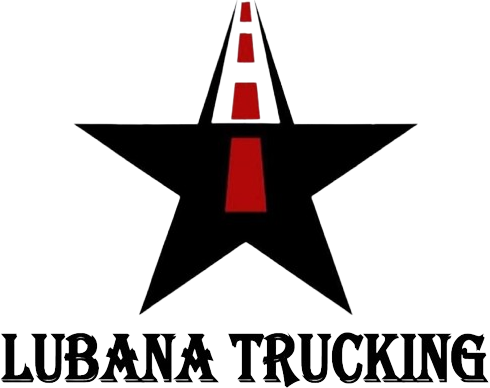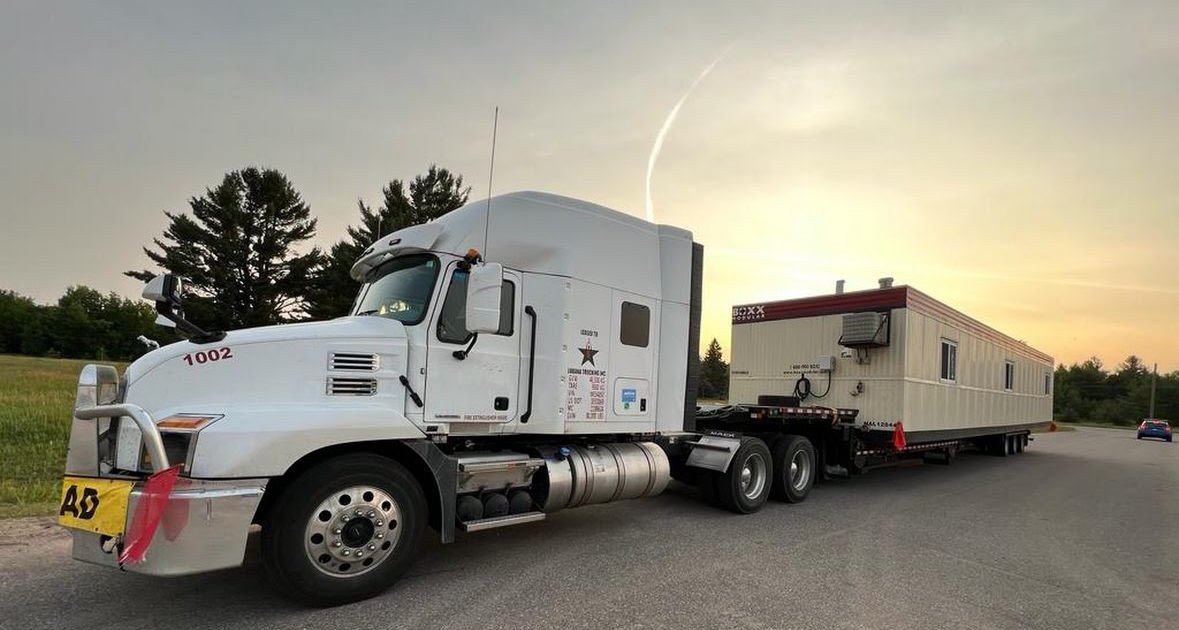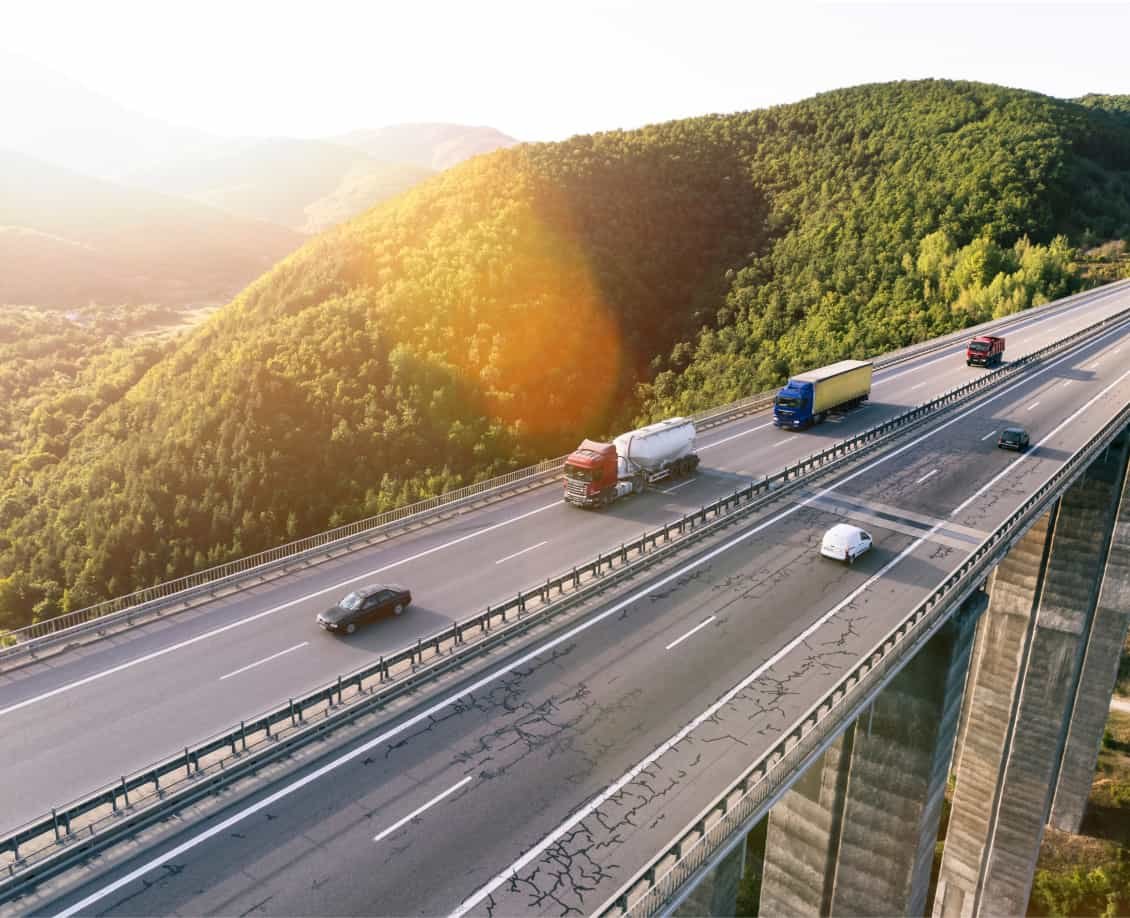WHY CHOOSE LUBANA FOR YOUR OVERSIZED TRANSPORT REQUIREMENTS IN NORTH AMERICA?
LUBANA offers specialized transportation solutions for large, heavy, or complex cargo, as well as all required papers and permissions. Whatever your transportation needs are, we will supply you with innovative and adaptive solutions. LUBANA offers a high-performance service that specializes in large freight transportation, delivery, and handling. LUBANA creates appropriate plans for each situation based on our experience and knowledge gained over many years of operation.
LUBANA provides specialized transportation for a variety of ‘long, broad, or high’ oversize loads, including structural steel, agricultural, construction, mining tools or equipment, and transportable buildings, as well as just about anything that exceeds in gauge transport standards. We can also arrange Permits, Pilots, and whatever else necessary to get your Oversize shipment to its destination. We provide finely tuned project management and dependable solutions for the urgent and important delivery and transfer of services throughout North America, providing complete client satisfaction.
WHAT IS AN OVERSIZED LOAD?
A cargo that exceeds the regular or ordinary legal size and/or weight limits for a vehicle to convey on a specific piece of road, highway, or other transport infrastructure, such as air freight or water freight, is referred to as an oversize load (or overweight load) in road transport. Construction machinery (cranes, front loaders, backhoes, etc.) are examples of oversize/overweight cargoes, as well as pre-built residences, containers, and construction pieces (bridge beams, generators, windmill propellers, rocket stages, industrial equipment). A load is characterized as abnormal when it cannot be deconstructed into units that can be transported without exceeding the dimensions and/or mass restrictions.
A vehicle that exceeds the permitted dimensions normally requires a special licence, which comes with additional payments, for the vehicle to legitimately travel on the highways. The permit normally outlines the route that the load must take as well as the dates and times that it may travel.
WHAT IS AN OVERSIZED TRANSPORT?
You might be wondering, “how can I transport oversized loads?” or “how to move an oversized load” and if you can do it yourself. Carrying massive things in your own car is challenging, and a truck is rarely the suitable vehicle for the job. It’s true! When you need to carry large loads, why make it hard for yourself, especially between regions. The procedure is also more difficult than you may think. Aside from knowing how to drive, you also need to know how to secure a load while complying to the rules of the road. That will just take some time and who wants to struggle with that?
Oversized cargo transportation is a difficult task that requires a considerable degree of expertise, relationships (inland carriers, big lift shipowners), and prior experience with such complex transportation needed. Working in similar conditions for many years gives you experience. It’s often important to act quickly while understanding the risks of making a mistake. This is the difference between amateur and professional in the transport of large and heavy cargo.
That’s where oversized transportation comes into the rescue!
Here are a few factors you should consider when transporting oversized loads:
- Oversized Truck Size Limits and Rules:
When transporting huge cargo, especially interstate shipments, you can’t just pick any truck. It’s critical to understand the legal-size limits, which differ significantly depending on where you are. However, for all heavy trucks, the height limit is 4.3 meters and the width restriction is 2.5 meters. Depending on the type of vehicle and the amount carried, there are a few exceptions. Experienced oversized load transportation companies would already be familiar with these laws and conditions – or, at the very least, will conduct thorough research as part of developing a service plan.
- Weight Limitations:
When transporting oversized loads, weight is often a major consideration. Some loads need the use of a specific set of axles. The problem is that on some highways, the number of axles is limited to a specific range.
- Vehicles Included When Oversized Transportation is in Session:
The truck that transports the cargo is frequently not the only vehicle in the operation. A police escort or a pilot automobile may be required depending on the size of the haul. The rules change depending on the amount of the load, the length of time it will be transported, and the type of vehicle it will be transported in.
- Safety Indicators to Conduct:
In most circumstances, a truck must contain many safety signs. Flashing lights may also be required, ensuring that the vehicle is seen on the road regardless of the weather or light conditions.
It can take a long time to research the factors listed above. You can save time by hiring a company that specializes in oversized transportation. The team can contact your state’s and destination’s transportation departments. All rules will be followed, and your items will arrive at their destination without a single problem.
HOW TO TRANSPORT OVERSIZED LOADS
There are a few rules that must be followed before moving big loads:
- Vehicles must be the correct weight and dimension.
- Escort service (if required)
- Permits
- Road limits should be understood.
Working with a heavy hauling company means you won’t have to worry about obtaining the necessary permissions. The business will gather all of them on your behalf.
Although a shipment may not exceed the total weight restriction, per-axle weight restrictions may be violated. In this scenario, changing the load is something that is required to make the cargo legal thus, it can avoid the requirement for extra licenses.
The width of a shipment is the most prevalent measurement that places it in the “oversize” category. To transport oversized loads, items that are more than 8.5 feet wide; shipments that are more than 12 feet wide may require one or two pilot vehicles at the front and/or back of the flatbed truck. Remember that flatbed drivers are responsible for getting permits, and they will not be able to obtain an oversize permit for any load that can be broken down in weight.
Flags or lights on the truck or trailer are essential depending on the size of the item being transported. For big loads, red flags and amber lights are usually required to ensure visibility to other traffic. Flags and/or lights are frequently required for travel escorts following an oversize cargo.
As a consumer, you may want to be flexible with your driving schedule because some big loads are not permitted at certain times of the day. Because certain routes and city centers may not be able to handle the volume, the route should be planned carefully. It may be essential to consult with police and local government, depending on the contents in the truck.
The importance of safety should not be underestimated. Trying to maneuver a massive vehicle while hauling a large load is a more challenging job. When reversing, this statement is especially true. When reversing, the driver must be concerned about limited visibility, which is a common problem. It might result in serious injury or death if the driver is not careful and does not know what he is doing. As a result, carefully analyzing and preserving the entire path of the travel to memory becomes a requirement. Heavy hauls can be difficult to load and unload, which is why special equipment is frequently required. Upon arrival, forklifts, mobile cranes, or lifting equipment may be required to remove the shipment from the vehicle.
THINGS TO CONSIDER WHILST LOOKING FOR OVERSIZED TRANSPORT COMPANIES
You must be careful when hiring an oversized transportation company, just as you must be cautious and aware when using any other service provider. It should never come down to money. Many consumers make the mistake of picking the cheapest oversized cargo transportation business they could find. However, there is always a reason why companies choose to minimize costs. Logistics require qualified and competent people with years of experience, as well as the appropriate vehicle and equipment. The only way for this specialized field to become inexpensive is to provide poor service, not ideal.
However, quality does not have to be ridiculously expensive – but it also cannot be cheap. Investing in the right personnel and supporting the training of company personnel through training and job upgrades can be expensive. It is crucial for a business to provide a secure service to its customers.
Aside from avoiding questionable oversized transportation companies that advertise cheap services, there are a few additional things to look for when hiring a transport company for your huge hauls:
- A Professional Vehicle Service
It is critical to use appropriate vehicles for heavy hauling to ensure that the items arrive safely at their destination. Flat top trailers, drop deck trailers, prime movers, and steerable jinkers are some of the most frequent vehicles used.
- Service is tailored to you
Each client has distinct requirements. A credible business understands how to address these special requirements by identifying all aspects that affect the entire transport.
- Detail Oriented
There are a variety of restrictions, requirements, and prerequisites that must be followed when transporting oversized loads. Before even getting on the road, the company you should hire must double-check every requirement that is noted.
Each state sets its own legal axle weight limits. It is important to know the limit for each state on your route before setting out. The best source of information is the Department of Transportation website for each state. The information below, taken from this resource, is provided for your convenience.
| State | Gross Weight | Single Axle | Double Axle | Tri-Axle |
| Alabama | 80,000 lbs. on Interstate highways | 20,000 lbs. | 34,000 lbs. on Interstate highways | 42,000 lbs. |
| Alaska | No defined upper limit. | 20,000 lbs. | 38,000 lbs. | 42,000 lbs. |
| Arizona | 80,000 lbs. | 20,000 lbs. | 34,000 lbs. | Per state weight table |
| Arkansas | 80,000 lbs. | 20,000 lbs. | 34,000 lbs. | 50,000 |
| California | 80,000 lbs. | 20,000 lbs. | 34,000 lbs. | Not defined in statute but subject to provisions |
| Colorado | Interstates: 80,000 lbs. | 20,000 lbs. | 36,000 lbs. on Interstates | Per FBF |
| Connecticut | 73,000 lbs. or | 22,400 lbs. per axle | 36,000 lbs. | Per FBF |
| Delaware | Up to 80,000 lbs. | 20,000 lbs. on Interstates and U.S. numbered routes | 34,000 lbs. on Interstates and U.S. numbered routes | 60,000 lbs. on all other highways |
| District of Columbia | 79,000 lbs. | 20,000 lbs. when GVW is 73,000 lbs. or greater | 34,000 lbs. when GVW is 73,000 lbs. or greater | Per district’s weight table |
| Florida | 80,000 lbs. | 20,000 lbs. | 40,000 lbs. | Per FBF |
| Georgia | 80,000 lbs. | 20,340 lbs. | 34,000 lbs. | Per FBF |
| Hawaii | 11,250 lbs. per single tire | 22,500 lbs. | 34,000 lbs. | 42,500 lbs. |
| Idaho | 80,000 lbs. | 20,000 lbs. | 34,000 lbs. | Per state weight table |
| Illinois | 80,000 lbs. | 20,000 lbs. | 34,000 lbs. | Not defined in statute |
| Indiana | 80,000 lbs. | 20,000 lbs. | 34,000 lbs. | 48,000 lbs. |
| Iowa | 80,000 lbs. | 20,000 lbs. | 35,000 lbs. | Per state weight table |
| Kansas | 80,000 lbs. on | 20,000 lbs. | 34,000 lbs. | 42,000 lbs. |
| Kentucky | Up to 80,000 lbs. | 20,000 lbs. | 34,000 lbs. | 48,000 lbs. |
| Louisiana | 80,000 lbs. | 18,000 lbs. | 32,000 lbs. | 42,000 lbs. |
| Maine | 80,000 lbs. | 20,000 lbs. | 34,000 lbs. | 45,000 lbs. |
| Maryland | 80,000 lbs. | 20,000 lbs. | 34,000 lbs. | Per state weight table |
| Massachusetts | 80,000 lbs. | 18,000 lbs. | 34,000 lbs. | Per state weight table |
| Michigan | 80,000 lbs. or less | 20,000 lbs. | 34,000 lbs. | Per state weight table |
| Minnesota | 80,000 lbs. | 10,000 lbs. per single tire | 34,000 lbs. | 42,000 lbs. |
| Missouri | 80,000 lbs. | 20,000 lbs. | 34,000 lbs. | Per state weight table |
| Mississippi | 80,000 lbs. | 20,000 lbs. | 34,000 lbs. | Per state weight table |
| Montana | 131,060 lbs. | 20,000 lbs. | 34,000 lbs. | Per state weight table |
| Nebraska | 80,000 lbs. | 20,000 lbs. | 34,000 lbs. | Per state weight table |
| Nevada | 80,000 lbs. | 20,000 lbs. | 34,000 lbs. | Per state weight table |
| New Hampshire | 80,000 lbs. | 20,000 lbs. | 34,000 lbs. | Per state weight table |
| New Jersey | 80,000 lbs. | 20,000 lbs. | 34,000 lbs. | n/a |
| New Mexico | 86,400 lbs. | 21,600 lbs. | 34,200 lbs. | Per state weight table |
| New York | 80,000 lbs. | 20,000 lbs. | 34,000 lbs. | Per FBF |
| North Carolina | 80,000 lbs. | 20,000 lbs. | 38,000 lbs. | Per state weight table |
| North Dakota | 80,000 lbs. | 20,000 lbs. | 17,000 lbs. per axle | Determined by FBF |
| Ohio | 80,000 lbs. | 20,000 lbs. | 34,000 lbs. | FBF on Interstate highways |
| Oregon | 80,000 lbs. | 20,000 lbs. | 34,000 lbs. | Per state weight table |
| Oklahoma | 80,000 lbs. | 20,000 lbs. | 34,000 lbs. | Per state weight table |
| Pennsylvania | 80,000 lbs. | 20,000 lbs. | 34,000 lbs. | Per state weight table |
| Rhode Island | 80,000 lbs. | 22,400 lbs. | 36,000 lbs. | NA |
| South Carolina | 73,280 lbs. | 10,000 lbs. per wheel | 35,200 lbs. | Per state weight table |
| South Dakota | 80,000 lbs. | 20,000 lbs. | 34,000 lbs. | Per FBF |
| Tennessee | 80,000 lbs. | 20,000 lbs. | 34,000 lbs. | 54,000 lbs. |
| Texas | 80,000 lbs. | 20,000 lbs. | 34,000 lbs. | NA |
| Utah | 80,000 lbs. | 20,000 lbs. | 34,000 lbs. | NA |
| Vermont | 80,000 lbs. | 20,000 lbs. | 34,000 lbs. | NA |
| Virginia | 80,000 lbs. | 20,000 lbs. | 34,000 lbs. | NA |
| Washington | 105,500 lbs. | 20,000 lbs. | Per State weight table | NA |
| West Virginia | 80,000 lbs. | 20,000 lbs. | 34,000 lbs. | Per FBF Interstate and STRAHNET |
| Wisconsin | 80,000 lbs. | 20,000 lbs. | 34,000 lbs. | Not defined in statute, subject to state’s bridge formula |
| Wyoming | 80,000 lbs. | 20,000 lbs. | 34,000 lbs. | 42,000 |



